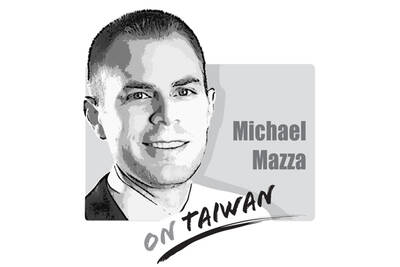On a regular day, Tainan goes to sleep at about 9pm, but Nov. 17 was different. A grandiose wedding was held at the Tainan Art Museum, and Youai Street, Nanmen Road and the area near the National Museum of Taiwan Literature and the Chianan Irrigation Association were full of excited fans late into the night.
Halfway through the event, Taiwanese model and actress Lin Chi-ling (林志玲) and Japanese dancer Akira appeared on the second floor balcony, greeting fans as love filled the air and city councilors’ protests at her being allowed to marry in a historical building were all but forgotten.
Some media outlets reported that when Lin waved at her fans, there was the air of a royal wedding, and everyone hoped that the prince and princess would live happily ever after.
Stars often prefer to marry in luxurious small islands with a small number of VIPs in attendance. If not on an island, they still pick luxury hotels in some secret, secluded place together with friends, politicians, business tycoons, and celebrities, far away from ordinary people.
Lin, however, was different: she descended from the stars, stepped out of the silver screen and walked among ordinary people, returning to her father’s hometown, where her parents’ love story began.
Furthermore, she chose a museum, which is very rare, and piqued the interest of those who wanted to see what a museum wedding would be like.
There were reports that every hotel and bed-and-breakfast in Tainan was booked out and Lin, unexpectedly, promoted Tainan tourism. It was an extraordinarily harmonious and beautiful experience to see her and her husband stand at the museum’s entrance to let fans take pictures and to receive their well-wishes.
Whether museums — great educational symbols — can serve as wedding venues and whether wedding banquets can be held in historical buildings is worth further discussion. After all, as long as it does not damage the building or affect pictures, paintings or cultural relics, using such venues for other activities after business hours is becoming a trend among museums.
Judging from Lin and Akira’s pictures and news reports, the banquet was held in the central hall at the museum’s Hall 1, an ingenious way to eliminate the risk to the historical artifacts.
The main building of Tainan Art Museum Hall 1, a designated municipal historic site, was completed in 1931 and originally housed the Tainan Police Department. Together with Hall 2, it is in the West Central District (中西區), making it one of a cluster of museums in the Minsheng Green Park Cultural Zone, together with the National Museum of Taiwan Literature, the Judicial Museum, the Yeh Shyr-Tau Literary Memorial Museum and the Tainan City Fire Museum. It is also close to the Confucius Temple and the Hayashi department store, and a good place to visit, infused with culture as it is.
The couple’s wedding day coincided with a forum on museums at the National Museum of Taiwan Literature, just across from the Tainan Art Museum.
As the news of the wedding spread, visitor numbers shot up. It is worth discussing if museums, in addition to their collections and educational, research and leisure functions, can also serve other purposes.
Chen Yuchen is a research assistant at the National Museum of Taiwan Literature.
Translated by Perry Svensson
The image was oddly quiet. No speeches, no flags, no dramatic announcements — just a Chinese cargo ship cutting through arctic ice and arriving in Britain in October. The Istanbul Bridge completed a journey that once existed only in theory, shaving weeks off traditional shipping routes. On paper, it was a story about efficiency. In strategic terms, it was about timing. Much like politics, arriving early matters. Especially when the route, the rules and the traffic are still undefined. For years, global politics has trained us to watch the loud moments: warships in the Taiwan Strait, sanctions announced at news conferences, leaders trading
The saga of Sarah Dzafce, the disgraced former Miss Finland, is far more significant than a mere beauty pageant controversy. It serves as a potent and painful contemporary lesson in global cultural ethics and the absolute necessity of racial respect. Her public career was instantly pulverized not by a lapse in judgement, but by a deliberate act of racial hostility, the flames of which swiftly encircled the globe. The offensive action was simple, yet profoundly provocative: a 15-second video in which Dzafce performed the infamous “slanted eyes” gesture — a crude, historically loaded caricature of East Asian features used in Western

Is a new foreign partner for Taiwan emerging in the Middle East? Last week, Taiwanese media reported that Deputy Minister of Foreign Affairs Francois Wu (吳志中) secretly visited Israel, a country with whom Taiwan has long shared unofficial relations but which has approached those relations cautiously. In the wake of China’s implicit but clear support for Hamas and Iran in the wake of the October 2023 assault on Israel, Jerusalem’s calculus may be changing. Both small countries facing literal existential threats, Israel and Taiwan have much to gain from closer ties. In his recent op-ed for the Washington Post, President William
A stabbing attack inside and near two busy Taipei MRT stations on Friday evening shocked the nation and made headlines in many foreign and local news media, as such indiscriminate attacks are rare in Taiwan. Four people died, including the 27-year-old suspect, and 11 people sustained injuries. At Taipei Main Station, the suspect threw smoke grenades near two exits and fatally stabbed one person who tried to stop him. He later made his way to Eslite Spectrum Nanxi department store near Zhongshan MRT Station, where he threw more smoke grenades and fatally stabbed a person on a scooter by the roadside.